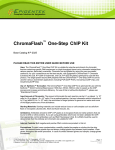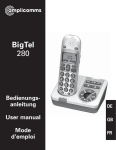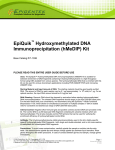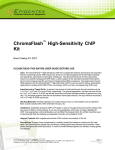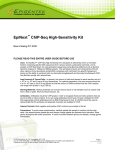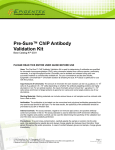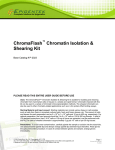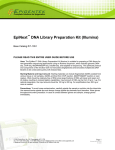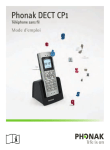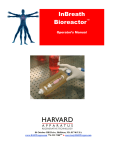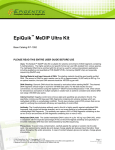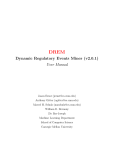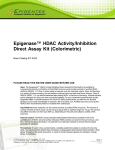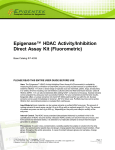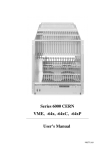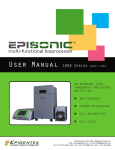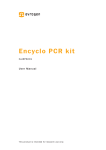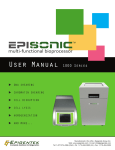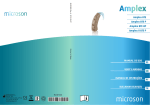Download ChromaFlash™ One-Step Magnetic ChIP Kit
Transcript
EPIGENTEK Complete Solutions for Epigenetics ChromaFlash™ One-Step Magnetic ChIP Kit Base Catalog # P-2026 PLEASE READ THIS ENTIRE USER GUIDE BEFORE USE Uses: The ChromaFlash™ One-Step Magnetic ChIP Kit is suitable for selective enrichment of a chromatin fraction containing specific DNA sequences in a high throughput format using chromatin isolated from various species, particularly mammals. Chromatin can be isolated by using your own successful method or, for your convenience and the best results, with Epigentek’s ChromaFlash™ Chromatin Extraction Kit (Cat. # P-2001 for mammals) optimized for use with this product. The target protein bound DNA prepared with the ChromaFlash™ One-Step Magnetic ChIP Kit can be used for various downstream applications including PCR (ChIP-PCR), microarrays (ChIP-chip), and sequencing (ChIP-seq). Use of EpiSonic™ Sonication: The ChromaFlash™ One-Step Magnetic ChIP Kit is optimized for use with the EpiSonic™ Multi-Functional Bioprocessor 1000 (Cat. # EQC-1000) in order to speed up the ChIP process and increase enrichment efficiency. For use of this kit without the EpiSonic™, please see “Standalone Protocol”. Input Amount of Chromatin: The amount of chromatin for each reaction can be 0.1 µg (about 1 x 104 cells) to 15 µg (about 1.5 x 106 cells). For an optimal reaction, the input chromatin amount should be 5 to 10 µg (about 0.5 to 1 x 106 cells), as enrichment of target proteins to genome loci varies and some of the target proteins are of low abundance. Starting Materials: Starting materials can include various tissue or cell samples such as cells from flask or microplate cultured cells, fresh and frozen tissues, etc. Antibodies: Antibodies should be ChIP or IP grade as to recognize fixed and native proteins that are bound to DNA or other proteins. If you are using antibodies which have not been validated for ChIP, then appropriate control antibodies such as RNA Polymerase II (Cat. # A-2032) should be used to demonstrate that the antibody and chromatin are suitable for ChIP. Internal Control: Both negative and positive DNA controls are provided in this kit. Precautions: To avoid cross-contamination, carefully pipette the sample or solution into the strip wells. Use aerosol-barrier pipette tips and always change pipette tips between liquid transfers. Wear gloves throughout the entire procedure. In case of contact between gloves and sample, change gloves immediately. 110 Bi County Blvd. Ste. 122, Farmingdale, NY 11735 Tel: 1-877-374-4368 ■ Fax: 1-718-484-3956 ■ E-mail: [email protected] ■ Web: www.epigentek.com © Epigentek Group Inc. All rights reserved. Products are for research use only. Page 1 Printed 2014-05-29 P-2026 EPIGENTEK Complete Solutions for Epigenetics KIT CONTENTS Component 48 reactions Cat. #P-2026-48 96 reactions Cat. #P-2026-96 Storage Upon Receipt CH1 (10X Wash Buffer) 10 ml 20 ml 4°C CH2 (ChIP Buffer) 6 ml 12 ml RT CH3 (DNA Release Buffer) 14 ml 28 ml RT Non-Immune IgG (1 m g/ml)* 10 µl 20 µl 4°C Anti-RNA Polymerase II (1 m g/ml)* 8 µl 16 µl 4°C Proteinase K (10 mg/ml)* 55 µl 110 µl 4°C GAPDH Primer - Forward (20 µM)* 8 µl 16 µl 4°C GAPDH Primer - Reverse (20 µM)* 8 µl 16 µl 4°C 8-Well Strip Caps 12 24 RT 96-Well PCR Plate 2 2 RT Magnetic Beads 220 µl 450 µl 4°C User Guide 1 1 RT * Spin the solution down to the b ottom prior to use. SHIPPING & STORAGE The kit is shipped in two parts: the first part at ambient room temperature and the second part on frozen ice packs at 4°C. Upon receipt: (1) Store CH1, Non-Immune IgG, Anti-RNA Polymerase II, Proteinase K, GAPDH Primer – Forward, GAPDH Primer – Reverse, and Magnetic Beads at 4°C away from light; (2) Store remaining components at room temperature away from light. All components of the kit are stable for 6 months from the date of shipment, when stored properly. Note: Check if CH1 (10X Wash Buffer) contains salt precipitates before use. If so, briefly warm at room temperature or 37°C and shak e the buffer until the salts are re-dissolved. MATERIALS REQUIRED BUT NOT SUPPLIED Variable temperature waterbath or incubator oven Thermalcycler with 48 or 96 well block EpiSonic™ Multi-Functional Bioprocessor 1000 (Epigentek Cat #EQC-1000) Incubator oven with variable temperature Orbital shaker Magnetic stand (96-well format) 110 Bi County Blvd. Ste. 122, Farmingdale, NY 11735 Tel: 1-877-374-4368 ■ Fax: 1-718-484-3956 ■ E-mail: [email protected] ■ Web: www.epigentek.com © Epigentek Group Inc. All rights reserved. Products are for research use only. Page 2 Printed 2014-05-29 P-2026 EPIGENTEK Complete Solutions for Epigenetics Adjustable pipette and multichannel pipette Aerosol resistant pipette tips 0.2ml or 0.5 ml PCR tubes Antibodies of interest OPTIONAL MATERIALS Microplate centrifuge Rolling shaker GENERAL PRODUCT INFORMATION Quality Control: Each lot of the ChromaFlash™ One-Step Magnetic ChIP Kit is tested against predetermined specifications to ensure consistent product quality. Epigentek guarantees the performance of all products in the manner described in our product instructions. Product Warranty: If this product does not meet your expectations, simply contact our technical support unit or your regional distributor. We also encourage you to contact us if you have any suggestions about product performance or new applications and techniques. Safety: Suitable lab coat, disposable gloves, and proper eye protection are required when working with this product. Product Updates: Epigentek reserves the right to change or modify any product to enhance its performance and design. The information in this User Guide is subject to change at any time without notice. Thus, only use the User Guide that was supplied with the kit when using that kit. Usage Limitation: The ChromaFlash™ One-Step Magnetic ChIP Kit is for research use only and is not intended for diagnostic or therapeutic application. Intellectual Property: The ChromaFlash™ One-Step Magnetic ChIP Kit and methods of use contain proprietary technologies by Epigentek. A BRIEF OVERVIEW Protein-DNA interaction plays a critical role for cellular functions such as signal transduction, gene transcription, chromosome segregation, DNA replication and recombination, and epigenetic silencing. Identifying the genetic targets of DNA binding proteins and knowing the mechanisms of protein-DNA interaction is important for understanding cellular process. Chromatin immunoprecipitation (ChIP) offers an advantageous tool for studying protein-DNA interactions. It allows for the detection that a specific protein binds to the specific sequences of a gene in living cells by PCR (ChIP-PCR), microarrays (ChIP-chip), or sequencing (ChIP-seq). For 110 Bi County Blvd. Ste. 122, Farmingdale, NY 11735 Tel: 1-877-374-4368 ■ Fax: 1-718-484-3956 ■ E-mail: [email protected] ■ Web: www.epigentek.com © Epigentek Group Inc. All rights reserved. Products are for research use only. Page 3 Printed 2014-05-29 P-2026 EPIGENTEK Complete Solutions for Epigenetics example, measurement of the amount of methylated histone H3 at lysine 9 (meH3-K9) associated with a specific gene promoter region under various conditions can be achieved through a ChIP -PCR assay, while the recruitment of meH3-K9 to the promoters on a genome-wide scale can be detected by ChIPchip. In particular, ChIP with antibodies directly against various transcriptional factors is widely demanded. However, currently used ChIP methods have several drawbacks of which the most critical weakness is lengthy procedures, often taking up to 3 days to finish the procedures. Additionally, the labor-intensive procedure involves an excessive amount of steps, inconsistency, and sub-optimized chromatin shearing. These flaws result in inconvenience, low throughput processing, and less enrichment efficiency. Epigentek first addressed these issues in 2005 by reducing the entire ChIP procedure to 5 hours in addition to improving upon performance and efficiency, and now further refines its ChIP expertise with the ChromaFlash™ technology. Because the major features of next generation sequencing and microarrays are their rapidness and high throughput capabilities, these technologies are becoming major players in massive protein-DNA analysis. To be compatible with these new technologies, rapid and massive generation of target protein-bound DNA is critically required. To meet this requirement, Epigentek further developed a new ChIP technology called, ChromaFlash™ and incorporated it into its ChromaFlash™ One-Step Magnetic ChIP Kit. With this kit and utilizing the EpiSonicTM Multi-Functional Bioprocessor 1000, chromatin shearing and immunoprecipitation can be simultaneously processed, which greatly advances ChIP to the highest speeds in a high throughput format with higher efficiency. The ChromaFlash™ One-Step Magnetic ChIP Kit has the following advantages: The fastest and most convenient ChIP method. The entire procedure (from intact chromatin sample to ready-for-use DNA) is less than 60 minutes with the actual handling time being less than 10 minutes due to simultaneous processing of chromatin shearing and immunoprecipitat ion ("One-Step ChIP"). 96-well plate format mak es the assay flexible. Either (a) manual with one single reaction each time; or (b) high throughput with 96 reactions each time. Highly efficient enrichment. Enrichment ratio of positive to negative control > 120, and an extremely low number of cells required (as low as 10,000 cells per ChIP reaction). High reproducibility. Pre-optimized ChIP conditions and– with the EpiSonic Multi-Functional Bioprocessor 1000– digitally acoustic-controlled reaction processing in sealed vials make the ChIP procedure consistent. Wide downstream analysis compatibility. Compatible with various downstream analysis workflows including ChIP-PCR, ChIP-on-chip, and ChIP-seq. PRINCIPLE & PROCEDURE The ChromaFlash™ One-Step Magnetic ChIP Kit contains all necessary reagents required for carrying out a successful chromatin immunoprecipitation directly from chromatin extracts isolated from mammalian cells or tissues. This kit includes a positive control antibody (RNA polymerase II), a negative control non-immune IgG, and GAPDH primers that can be used as a positive control to demonstrate the efficacy of the kit reagents and protocol. RNA polymerase II is considered to be enriched in the GAPDH gene promoter that is expected to be undergoing transcription in most growing mammalian cells and can be immunoprecipitated by RNA polymerase II but not by non-immune IgG. Immunoprecipitated DNA is then cleaned, released, and eluted. Eluted DNA can be used for various downstream applications such as ChIP-PCR, ChIP-on-chip, and ChIP-seq. 110 Bi County Blvd. Ste. 122, Farmingdale, NY 11735 Tel: 1-877-374-4368 ■ Fax: 1-718-484-3956 ■ E-mail: [email protected] ■ Web: www.epigentek.com © Epigentek Group Inc. All rights reserved. Products are for research use only. Page 4 Printed 2014-05-29 P-2026 EPIGENTEK Complete Solutions for Epigenetics Relative Enrichment Fold 250 Normal mouse IgG RNA polymerase II 200 150 100 50 0 GAPDH Schematic procedure of the ChromaFlash™ One-Step Magnetic ChIP Kit MLH1 Fig 1. The data abov e shows the analy sis of enrichment of RNA poly merase II in GAPDH and MLH1 promoters by the ChromaFlash One-Step Magnetic ChIP Kit, with chromatin extract prepared f rom f ormaldehy de f ixed colon cancer cells. Captured DNA was used f or analy zing lev els of RNA poly merase II enriched in the GAPDH and MLH1 promoters. ASSAY PROTOCOL For the best results, please read the protocol in its entirety prior to starting your experiment. Starting Materials Input Chromatin Amount: Chromatin amount can range from 0.1 µg to 15 µg per reaction. An optimal amount is 5-10 µg per reaction. Chromatin Isolation: You can use your method of choice for chromatin isolation. Epigentek offers the ChromaFlash™ Chromatin Extraction Kit (Cat. # P-2001) for your convenience. Chromatin Storage: Isolated chromatin can be stored at –20°C or –80°C (long term) until use. 1. Preparation of 1X Wash Buffer (CH1) 48 Reactions Kit: Add 8 ml of CH1 10X Wash Buffer to 72 ml of distilled water (pH 7.2-7.5). 96 Reactions Kit: Add 16 ml of CH1 10X Wash Buffer to 144 ml of distilled water (pH 7.2-7.5). This Diluted CH1 1X Wash Buffer can now be stored at 4°C for up to six months. 2. Preparation of One-Step ChIP Reaction 110 Bi County Blvd. Ste. 122, Farmingdale, NY 11735 Tel: 1-877-374-4368 ■ Fax: 1-718-484-3956 ■ E-mail: [email protected] ■ Web: www.epigentek.com © Epigentek Group Inc. All rights reserved. Products are for research use only. Page 5 Printed 2014-05-29 P-2026 EPIGENTEK Complete Solutions for Epigenetics a. Predetermine the number of PCR wells required for your experiment. Cap the unused wells of the 96Well PCR Plate with the supplied 8-Well Strips Caps before continuing further to avoid any possible contamination. b. Setup the one-step ChIP reactions by adding the reagents to each well according to the following: Reagents Sample Positive Control Negative Control CH2 ChIP Buffer 55-75 µl 55-75 µl 55-75 µl Chromatin Your Antibodies 20-40 µl 0.5-2 µl 20-40 µl 0 20-40 µl 0 RNA Polymerase II Non-Immune IgG 0 0 0.8 µl 0 0 0.8 µl Magnetic Beads 4 µl 4 µl 4 µl Total Volume 100 µl 100 µl 100 µl Note: The final amount of each component should be (a) chromatin: 5-10 µg/well; (b) antibodies of interest: 0.8 µg/well; (c) RNA Polymerase II: 0.8 µg/well; and (d) non-immune IgG: 0.8 µg/well. Freshly prepared chromatin can be used directly for the reaction. Frozen chromatin samples should be thawed quick ly at RT and then placed on ice before use. Store remaining chromatin samples at –20°C, or at –80°C if they will not be used within 8 hours. The amounts of the positive control and negative control are sufficient for matched use with samples if two antibodies are used for each sample or one antibody is used for two of the same samples. If using one antibody of interest for each sample with matched use of the positive and negative control, extra RNA polymerase II and non-immune IgG required can be separately obtained from Epigentek. Input DNA control is only used for estimating the enrichment efficiency of ChIP and is generally not necessary as the positive and negative control can be used for estimating the same objective more accurately. If you would lik e to include the input DNA control, the following steps can be carried out: (1) add 10 µl of each chromatin sample to a 0.2 ml PCR tube followed by adding 88 µl of CH3 and 2.5 µl of Proteinase K; (2) incubate the input DNA control at 65°C for 15 min, then incubate at 95°C for 10 min; and (3) spin the solution down to the bottom. Input DNA is ready for PCR or s torage at –20°C. c. Cap the reaction wells with the 8-Well Strip Caps and place the 96-Well PCR Plate to the platform of the sample processing horn of the EpiSonic™ Multi-Functional Bioprocessor 1000. d. Start up the EpiSonic™ by following the standard EpiSonic™ operation instructions. Slowly add icecold filtered water into the sample processing horn so that your sample contents in the strip wells are submerged just below the water level. e. Set the EpiSonic™ to the following program using the power output chart under “Optimization Suggestions” in its manual as a reference: 20 sec Pulse-ON at 120W 20 sec Pulse-OFF Total 20 duty cycles (Total ON time should be 3:40) 10 min ON at 40W 110 Bi County Blvd. Ste. 122, Farmingdale, NY 11735 Tel: 1-877-374-4368 ■ Fax: 1-718-484-3956 ■ E-mail: [email protected] ■ Web: www.epigentek.com © Epigentek Group Inc. All rights reserved. Products are for research use only. Page 6 Printed 2014-05-29 P-2026 EPIGENTEK Complete Solutions for Epigenetics The above program can be modified based on the amount of input chromatin and the cell/tissue type from which the chromatin is prepared from. For processing ChIP without using the EpiSonic™, see Standalone Protocol. f. Gently remove the 96-Well PCR Plate without tilting. If liquid is found in the caps, briefly spin the plate using a microplate centrifuge. 3. Washing of the Reaction Wells a. Carefully remove the caps from the reaction wells. b. Place the plate on a magnetic stand (96 well format) for 1-2 min in order to pellet the beads to the sides of the wells. c. Carefully remove and discard the solution from each reaction well. d. Wash each reaction well four times with 180 µl of the Diluted CH1 each time. Each wash can be performed as follows: Remove the plate from the magnetic stand (after solution has been removed) and add the Diluted CH1 to the reaction wells. Resuspend the beads by gently pipetting up and down several times. Ensure the pellet is completely resuspended and beads are not clinging to the pipette tips after pipetting. Place the plate back to the magnetic stand for 1-2 min to pellet the beads and then remove and discard the solution from each reaction well. e. Wash each reaction well one time with 180 µl of CH3 with the same wash procedure as above (using CH3 instead of Diluted CH1). f. Remove and discard the CH3 solution from each well. g. Remove the plate from the magnetic stand. 4. Reversal of Cross-Links, Release and Elution of DNA a. Prepare the CH3-PK solution by adding 1 µl of Proteinase K to each 39 µl of CH3, and mix. b. Add 40 µl of the CH3-PK solution to each reaction well, then cover with new strip caps. c. Incubate the wells at 65°C for 15 min and then 95ºC for 5 min in a thermal cycler. d. Remove the plate to room temperatue. If liquid is collected on the inside of the caps, briefly spin the liquid down to the bottom. e. Place the plate on the magnetic stand (96 well format) for 1-2 min to pellet the beads to the sides of the tubes/wells. f. Carefully transfer the supernatant from each reaction well to new 0.2 or 0.5 ml PCR tubes. Cap the PCR tubes. DNA is now ready for use or storage at –20°C. For real time PCR analysis, we recommend the use of 1-2 µl of eluted DNA in a 20 µl PCR reaction. If input DNA will be used, it should be diluted 10 fold before adding to PCR reaction. Control primers 110 Bi County Blvd. Ste. 122, Farmingdale, NY 11735 Tel: 1-877-374-4368 ■ Fax: 1-718-484-3956 ■ E-mail: [email protected] ■ Web: www.epigentek.com © Epigentek Group Inc. All rights reserved. Products are for research use only. Page 7 Printed 2014-05-29 P-2026 EPIGENTEK Complete Solutions for Epigenetics (110 bp, for human cells) included in the kit can be used as a positive control. For end point PCR, the number of PCR cycles may need to be optimized for better PCR results. In general, the amplification difference between “normal IgG control” and “positive control” may vary from 3 to 8 cycles, depending on experimental conditions. For ChIP-chip or ChIP-seq, additional DNA clean up and concentration steps may be needed. For your convenience, Epigentek offers a DNA Concentrator Kit (Cat. # P-1006) for DNA clean up and concentration TROUBLESHOOTING Problem Possible Cause Suggestion Little or No PCR Products Generated from both Sample and Positive Control Wells Poor chromatin quality due to insufficient amount of cells, or insufficient or over cross -linking. To obtain an optimal amount of chromatin per ChIP reaction should be 5-10 µg (about 0.5-1 x 10 6 cells). The minimum amount of chromatin is 0.05 µg (5,000 cells). Appropriate chromatin cross -linking is also required. Insufficient or overcrosslinking will cause DNA loss or increased background. During crosslinking step of chromatin preparation, ensure that the cross -linking time is within 10-15 min, the concentration of formaldehyde is 1% as the final concentration, and/or quench solution is 0.125 M glycine. Poor enrichment with antibody; some antibodies used in ChIP might not efficiently recognize fixed protein. Increase the antibody amount and use ChIP-grade antibodies validated for use in ChIP. Inappropriate DNA fragmenting condition. If chromatin is from specific cell/tissue types such as plant, or is differently fixed, the processing program must be modified (see EpiSonic™ manual) to optimize the processing results. If using a probe-based sonicator, shearing conditions should also be optimized to allow DNA fragment size to be between 200-1000 bp. Incorrect temperature and/or insufficient time during DNA release. Ensure the incubation times and temperatures described in the protocol are followed correctly. Improper PCR conditions, including improper PCR programming, PCR reaction solutions, and/or primers. Ensure the PCR is properly programmed. If using a homebrew PCR reaction solution, check if each component is 110 Bi County Blvd. Ste. 122, Farmingdale, NY 11735 Tel: 1-877-374-4368 ■ Fax: 1-718-484-3956 ■ E-mail: [email protected] ■ Web: www.epigentek.com © Epigentek Group Inc. All rights reserved. Products are for research use only. Page 8 Printed 2014-05-29 P-2026 EPIGENTEK Complete Solutions for Epigenetics correctly mixed. If using a PCR commercial kit, check if it is suitable for your PCR. Confirm species specificity of primers. Primers should be designed to cover a short sequence region (70-150 bp) for more efficient and precise amplification of target DNA region 9 binding sites of the protein of interest. Inproper sample storage. Chromatin sample should be stored at – 80°C for no longer than 6 months, preferably less than 3 months. Avoid repeated freeze/thaw cycles. DNA samples should be stored at –20°C for no longer than 6 months, preferably less than 3 months. No Difference in Signal Intensity Between Negative and Positive Control Wells Insufficient washing. Check if washing recommendations at each step is performed according to the protocol. If the signal intensity in the negative control is still high, washing stringency can be increased in the following ways: 1. Increase wash time at each wash step: after adding diluted CH1, leave it in the tubes/wells for 2-3 min and then remove it. 2. Add an additional one to two washes: The provided volume of Diluted CH1 is sufficient for 4 extra washes for each sample. Little or No PCR Products Generated From Sample Wells Only Too many PCR cycles; Pleateu phase of amplification caused by over-increased number of PCR cycles in endpoint PCR may mask the difference of signal intensity between negative contol and positive control. Decrease the number of PCR cycles (i.e., 32-35 cycles) to keep ampification at the exponential phase will reduce high background in endpoint PCR and allow differences in amplification to be seen. Poor enrichment with antibody; some antibodies used in ChIP might not efficiently recognize fixed protein. Increase the antibody amount and use ChIP-grade antibodies validated for use in ChIP. PCR primers are not optimized. Confirm species specificity of primers. Primers should be designed to cover a short sequence region (70-150 bp) for more efficient and precise amplification of target DNA region (binding sites of the protein of interest). Real time PCR is another choice in such cases. 110 Bi County Blvd. Ste. 122, Farmingdale, NY 11735 Tel: 1-877-374-4368 ■ Fax: 1-718-484-3956 ■ E-mail: [email protected] ■ Web: www.epigentek.com © Epigentek Group Inc. All rights reserved. Products are for research use only. Page 9 Printed 2014-05-29 P-2026 EPIGENTEK Complete Solutions for Epigenetics STANDALONE PROTOCOL This protocol is intended for use without the EpiSonic™ Multi-Functional Bioprocessor 1000. For the best results, please read the protocol in its entirety prior to starting your experiment. Starting Materials Input Chromatin Amount: Chromatin amount can range from 0.1 µg to 15 µg per reaction. An optimal amount is 5-10 µg per reaction. Chromatin Isolation: You can use your method of choice for chromatin isolation. Epigentek offers the ChromaFlash™ Chromatin Extraction Kit (Cat. # P-2001) for your convenience (see “Ordering Information” section at the end of this manual). Chromatin Storage: Isolated chromatin can be stored at –20°C (short term), or –80°C (long term) until use. 1. Chromatin Shearing If a probe-based sonicator will be used, the sonication settings need to be optimized by you. For example, DNA of 200-1000 bp size can be obtained by sonicating 3-4 pulses of 15-20 sec each at 40% output power using a Microson 1/8 inch Microtip probe, followed by a 30-40 sec rest period on ice between each pulse. If desired, remove 10 µl of sheared chromatin for DNA purification and agarose gel analysis along with a DNA marker on a 1 - 2% agarose gel, stained with ethidium bromide, and visualize it under ultraviolet light. 2. Preparation of 1X Wash Buffer (CH1) 48 Reactions Kit: Add 8 ml of CH1 10X Wash Buffer to 72 ml of distilled water (pH 7.2-7.5). 96 Reactions Kit: Add 16 ml of CH1 10X Wash Buffer to 144 ml of distilled water (pH 7.2-7.5). This Diluted CH1 1X Wash Buffer can now be stored at 4°C for up to six months. 3. Preparation of One-Step ChIP Reaction a. Predetermine the number of PCR wells required for your experiment. Cap the unused wells of the 96Well PCR Plate with the supplied 8-Well Strips Caps before continuing further to avoid any possible contamination. Plate can also be saved for later use. b. Setup the ChIP reactions by adding the reagents to each well according to the following chart: Reagents CH2 ChIP Buffer Sample 55-75 µl Positive Control 55-75 µl Negative Control 55-75 µl Chromatin 20-40 µl 20-40 µl 20-40 µl Your Antibodies RNA Polymerase II 0.5-2 µl 0 0 0.8 µl 0 0 Non-Immune IgG Magnetic Beads 0 4 µl 0 4 µl 0.8 µl 4 µl Total Volume 100 µl 100 µl 100 µl 110 Bi County Blvd. Ste. 122, Farmingdale, NY 11735 Tel: 1-877-374-4368 ■ Fax: 1-718-484-3956 ■ E-mail: [email protected] ■ Web: www.epigentek.com © Epigentek Group Inc. All rights reserved. Products are for research use only. Page 10 Printed 2014-05-29 P-2026 EPIGENTEK Complete Solutions for Epigenetics Note: The final amount of each component should be (a) chromatin: 5-10 µg/well; (b) antibodies of interest: 0.8 µg/well; (c) RNA Polymerase II: 0.8 µg/well; and (d) non-immune IgG: 0.8 µg/well. Freshly prepared chromatin can be directly used for the reaction. Frozen chromatin samples should be thawed quick ly at RT and then placed on ice before use. Store remaining chromatin samples at -20°C, or at –80°C if they will be not used within 8 hours. The amounts of the positive control and negative control are sufficient for matched use with samples if two antibodies used for each sample or one antibody is used for two of the same samples. If using one antibody of interest for each sample with matched use of the positive and negative control, extra RNA polymerase II and non-immune IgG required can be separately obtained from Epigentek. Input DNA control is only used for estimating the enrichment efficiency of ChIP and is generally not necessary as the positive and negative control can be used for estimating the same objective more accurately. If you would lik e to include the input DNA control, the following steps can be carried out: (1) add 10 µl of each chromatin sample to a 0.2 ml PCR tube followed by adding 88 µl of CH3 and 2.5 µl of Proteinase K; (2) incubate the input DNA control at 65°C for 15 min followed by incubating at 95°C for 10 min; and (3) spin the solution down to the bottom. Input DNA is ready for PCR or storage at –20°C. c. Cap the reaction wells with the 8-Well Strip Caps and place the 96-Well PCR Plate on a rolling shaker for 120 min. Tape the plate to the rolling shaker securely. d. Remove the plate from the rolling shaker. If liquid is found in the caps, briefly spin the plate down using a microplate centrifuge. 4. Washing of the Reaction Wells a. Carefully remove the caps from the reaction wells. b. Place the plate on a magnetic stand (96 well format) for 1-2 min in order to pellet the beads to the sides of the wells. c. Carefully remove and discard the solution from each reaction well. d. Wash each reaction well four times with 180 µl of the Diluted CH1 each time. Each wash can be performed as follows: Remove the plate from the magnetic stand (after solution has been removed) and add the Diluted CH1 to the reaction wells. Resuspend the beads by gently pipetting up and down several times. Ensure the pellet is completely resuspended and beads are not clinging to the pipette tips after pipetting. Place the plate back to the magnetic stand for 1-2 min to pellet the beads and then remove and discard the solution from each reaction well. e. Wash each reaction well one time with 180 µl of CH3 with the same wash procedure as above (using CH3 instead of Diluted CH1). f. Remove and discard the CH3 solution from each well. g. Remove the plate from the magnetic stand. 110 Bi County Blvd. Ste. 122, Farmingdale, NY 11735 Tel: 1-877-374-4368 ■ Fax: 1-718-484-3956 ■ E-mail: [email protected] ■ Web: www.epigentek.com © Epigentek Group Inc. All rights reserved. Products are for research use only. Page 11 Printed 2014-05-29 P-2026 EPIGENTEK Complete Solutions for Epigenetics 5. Reversal of Cross-Links, Release and Elution of DNA a. Prepare CH3-PK solution by add 1 µl of Proteinase K to each 39 µl of CH3 and mix. b. Add 40 µl of the CH3-PK solution to each well, then cover with new strip caps. c. Incubate the wells at 65°C for 15 min and then 95ºC for 5 min in a thermal cycler. d. Remove the plate to room temperatue. If liquid is collected on the inside of the caps, briefly spin the liquid down to the bottom. e. Place the plate on the magnetic stand (96 well format) for 1-2 min to pellet the beads to the sides of the tubes/wells. f. Carefully transfer the supernatant from each reaction well to new 0.2 or 0.5 ml PCR tubes. Cap the PCR tubes. DNA is now ready for use or storage at –20°C. For real time PCR analysis, we recommend the use of 1-2 µl of eluted DNA in a 20 µl PCR reaction. If input DNA will be used, it should be diluted 10 fold before adding to PCR reaction. Control primers (110 bp, for human cells) included in the kit can be used as a positive control. For end point PCR, the number of PCR cycles may need to be optimized for better PCR results. In general, the amplification difference between “normal IgG control” and “positive control” may vary from 3 to 8 cycles, depending on experimental conditions. For ChIP-chip or ChIP-seq, additional DNA clean up and concentration steps may be required. For your convenience, Epigentek offers a DNA Concentrator Kit (Cat. # P-1006) for DNA clean up and concentration. PCR ANALYSIS Real Time PCR Primer Design Primers designed should meet the criteria for real time PCR. For example, the covered sequence region should be 50-150 bp in length. G/C stretches at 3’ ends of primers should be avoided. PCR Reaction Real time PCR can be performed using your own proven method. For your convenience and best results, Epigentek offers the EpiQuik™ Quantitative PCR Kit (Cat #P-1029) which is optimized for fast qPCR reactions. As an example, the protocol is presented below: Prepare the PCR Reactions Thaw all reaction components including master mix, DNA/RNA free water, primer solution and DNA template. Mix well by vortexing briefly. Keep components on ice while in use, and return to –20˚C immediately following use. Add components into each well according to the following Co 110 Bi County Blvd. Ste. 122, Farmingdale, NY 11735 Tel: 1-877-374-4368 ■ Fax: 1-718-484-3956 ■ E-mail: [email protected] ■ Web: www.epigentek.com © Epigentek Group Inc. All rights reserved. Products are for research use only. Page 12 Printed 2014-05-29 P-2026 EPIGENTEK Complete Solutions for Epigenetics mponent Size (:l) Final Concentration Component Methylamp Master Mix (2X) Size (µl) 10 µl Final Concentration 1X Forward Primer 1 µl 0.4-0.5 µM Reverse Primer 1 µl 0.4-0.5 µM DNA Template DNA/RNA-free H 2O 1-2 µl 6-7 µl 50 pg-0.1 µg Total Volume 20 µl For the negative control, use DNA/RNA-free water instead of DNA template. Program the PCR Reactions Place the reaction plate in the instrument and set the PCR conditions as follow: Cycle Step Temp Time Cycle Activation 95°C 7 min 1 Cycling 95°C 55°C 72°C 10 sec 10 sec 8 sec 40 Final Extension 72° 1 min 1 Fold Enrichment Calculation Fold enrichment (FE) can be calculated by simply using a ratio of amplification efficiency of the ChIP sample over that of non-immune IgG. Amplification efficiency of Polymerase RNA II can be used as a positive control. FE % = 2(IgG CT – Sample CT) x 100% For example, if CT for IgG is 38 and the sample is 34, then… FE % = 2(38 – 34) x 100% = 1600% Endpoint PCR Primer Design Primers designed should meet the criteria for endpoint PCR. For example, the covered sequence region should be 100-400 bp in length. PCR primer design tools (e.g., Primer3Plus) can be used to help in the selection of appropriate primer pairs. PCR Reaction Endpoint PCR can be performed using your own proven method. It is important to stop the PCR reaction at the exponential phase by setting up an appropriate number of PCR cycles in order to make a reliable comparision of enrichment efficiency obtained from different ChIP reactions. Thus, the optimized number of PCR cycles should be determined empirically. PCR Product Analysis Endpoint PCR products can be analyzed by separating amplicons on a 1-2% agarose gel, followed by staining with ethidium bromide and visulizing with UV-illumination. 110 Bi County Blvd. Ste. 122, Farmingdale, NY 11735 Tel: 1-877-374-4368 ■ Fax: 1-718-484-3956 ■ E-mail: [email protected] ■ Web: www.epigentek.com © Epigentek Group Inc. All rights reserved. Products are for research use only. Page 13 Printed 2014-05-29 P-2026 EPIGENTEK Complete Solutions for Epigenetics RELATED PRODUCTS ChIP Reaction P-2025 ChromaFlash™ One-Step ChIP Kit Chromatin Preparation and Cleanup P-2001 ChromaFlash™ Chromatin Extraction Kit P-1006 DNA Concentrator Kit Sonication Instruments EQC-1000 EpiSonic™ Multi-Functional Bioprocessor 1000 PCR Analysis P-1029 EpiQuik™ Quantitative PCR Kit 110 Bi County Blvd. Ste. 122, Farmingdale, NY 11735 Tel: 1-877-374-4368 ■ Fax: 1-718-484-3956 ■ E-mail: [email protected] ■ Web: www.epigentek.com © Epigentek Group Inc. All rights reserved. Products are for research use only. Page 14 Printed 2014-05-29 P-2026














